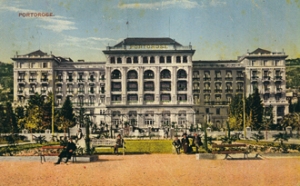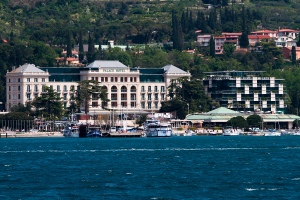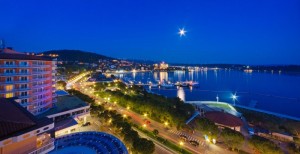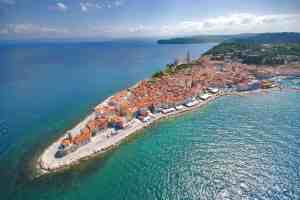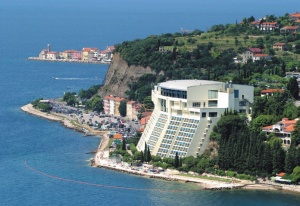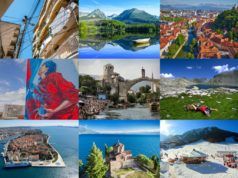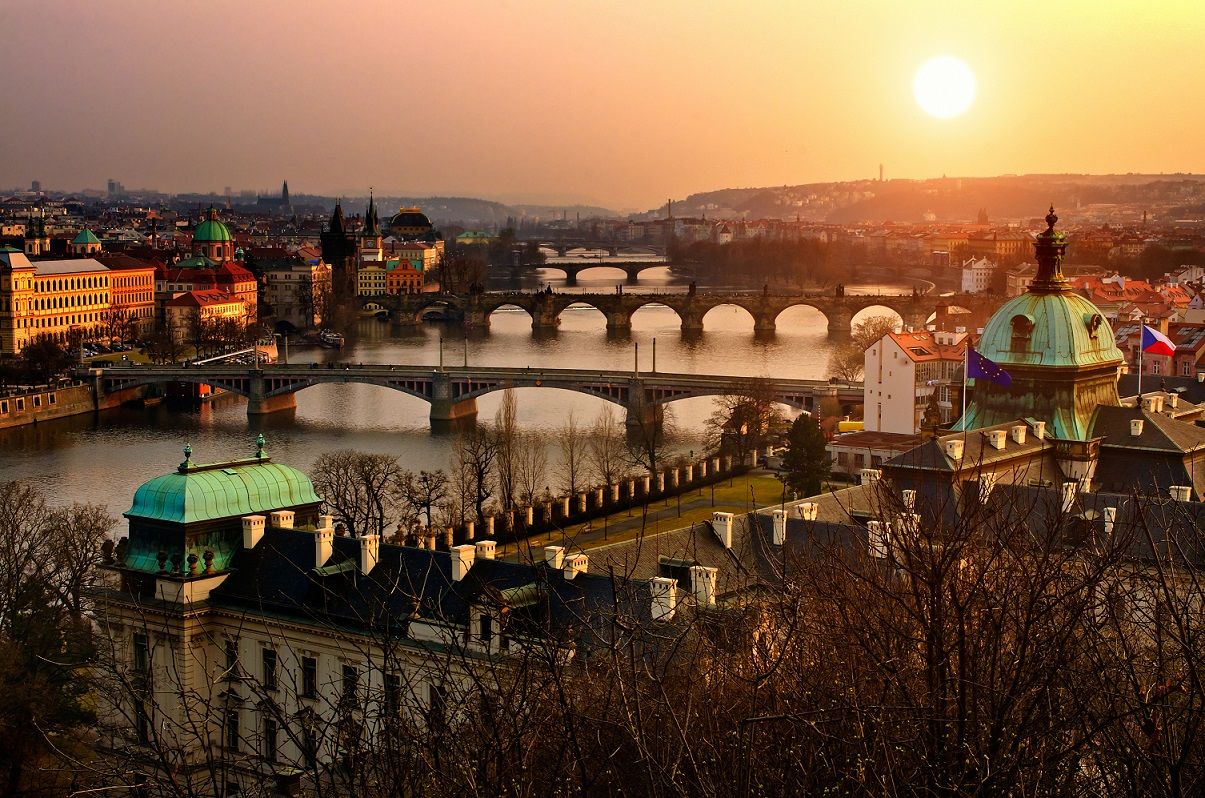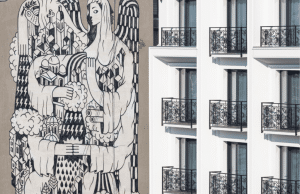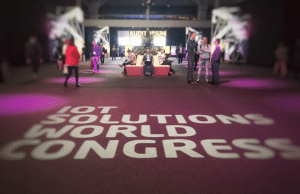From Portorož’s rich tourism history the story I remember most is that of the Benedictine monks who in the 13th century treated symptoms of rheumatism with the sea-mud from the nearby salt-pans. The convent of Saint Lawrence stood on the site of today’s hotel Metropol. The Josephinian Reforms signalled the last works of the monks in 1806, at the approximately same time as the foundling tourist development of Portorož started to take place.
The other story that I recall is about the legendary Palace hotel. Its predecessor was apparently built in 1891, based on the design of English health resorts. This was a period of intense development of tourism during which the promenade, the public bath and the pier with its restaurants were built. Portorož even had a seaplane station from 1897 and was officially declared a health resort. The prime area of the city is connected with hotel Palace, which was built between 1908 and 1912. With the Palace, Portorož became a luxurious resort, with the likes of Grado and Opatia adding to its offer. The Palace was high-spec for its time: it even hosted the first congresses and events in Portorož, especially the social events of its legendary Crystal Hall.
In 1921 Portorož hosted its first large international conference. It was the conference on the succession of the former states of the Austro-Hungarian empire. This major event can be regarded as the foundation of the meetings industry. The period of prosperity under Austrian rule was followed by one of decline of tourism, lasting until 1954, when the Slovenian coast was finally annexed to Yugoslavia.
The largest period of growth for Portorož was in the 1970s, with the completion of the hotels Metropol, Slovenija and Emona (now Bernardin). The urban planning framework for this was coordinated by Edo Mihevc, who also designed the Avditoriy Portorož, opened in 1972. At this time it was a modern convention centre, with its own PCO agency. In the period up to the dissolution of Yugoslavia, Portorož, along with Bled and Ljubljana, was the most important Slovenian congress centre and Avditorij the flagship of the meetings industry. The period coincides with the development of the Metropol casino, which many hold responsible for the development of a number of further tourist facilities along the coast.
The stagnation of the centre started directly after Slovenia’s independence. The hotel complexes were slowly growing, along with their congress capacities, and Avditorj was losing more and more business to them. In 2002 the convention centre Portus was built. In Bernardin the renovation of the biggest congress hotel in the country, able to host up to 2.600 participants, was finally finished.
 Dvorana Evropa, Hoteli Bernardin
Dvorana Evropa, Hoteli Bernardin
Portorož is unquestionably an appropriate destination for the meetings industry, given its climate, cultural diversity and range of social and leisure options. The architectural form of Portorož was defined by Edo Mihevc and includes colourful modernist architecture enriched with Mediterranean elements. Expensive yet accurate and precise renovation of the secessionist hotel Palace and several historic buildings ensured we can also still enjoy a part of its historic glamour too.
Piran also positively supports Portorož, with its medieval architecture and rich history. A lot of unexploited congress potential, or spin-off potential, is latent in the authentic Istrian villages in the hinterland.
The general infrastructure of Portorož is satisfactory. The traffic, however, is the town’s worst feature. The traffic regime, parking, public transport and green areas usually receive the most complaints. Many dislike the large salt warehouses on a precious costal location which are occasionally used as an event venue. The central beach has been much improved since 2010, but the problem of the coastal road between the hotels and the sea is still a difficult one to solve. The biggest infrastructure issue is air accessibility. The idea to extend the existing airline is old, but not likely to come true anytime soon. Also, it doesn’t seem likely that the airport will witness international air traffic in the near future. Meeting organisers are forced to use other airports in the vicinity. Reviving the airport would improve the competitiveness of the congress offer and facilitate easier access. I am certain Portorož will be able to solve this problem, since it once had a permanent seaplane connection to a number of Italian cities.
The tourist infrastructure of Portorož is currently still in step with the Croatian competition. Hotel capacities are broadly suitable and after the renovation of Kempinski Palace Hotel Portorož are able to host even the most demanding guests. Some 4 and 5 star hotels in the congress categories are reaching the point of requiring renovation and modernisation, as time has started to take a toll on them. Rooms need to be regularly renovated and adapted with additional and contemporary services to meet the demands of modern guests. All hotels came to the realisation that today free wireless internet is as necessary as water and electricity. Occasionally, however, in the transition period between the high tourist season and the congress season there are not enough rooms available in Portorož. The same situation can arise at the time of really big events.
In the low tourist and main congress season it appears that the nightlife is the more problematic part of the overall offer. The range of shops and boutiques open compromises the status of the destination and is constantly a target of sharp criticism from hoteliers and guests of the prestigious and congress hotels, as they struggle to be able to spend any money. The restaurants fare little better, being mostly average and, in fact, borderline fast food, again not doing justice to the hotel offer. For more demanding culinary adventures visitors need to travel into the hinterland, or at very least to Piran. Portorož is making great efforts with its events work, but for a breakthrough into the elite category it needs to re-attract some more exclusive events that it has previously hosted and from time to time look towards Koper, where they have become very innovative in the events arena.
The congress offer is concentrated in the Hotel Bernardin, which includes the largest congress hotel in the region, the congress centre Portus in Lifeclass hotels as well as the Kempinski and Metropol. The congress centres are modern, with high-tech equipment and in good condition. Bernardin is one of the largest congress centres in the Adriatic and can host up to 2,600 participants in its 16 multi-function halls. The biggest hall, Evropa, can seat 1,100 people. This makes it appropriate for larger events and it has hosted the Golden Drum Festival and for the past several years a number of other annual conferences and events. Congress centre Portus is smaller and consists of seven halls, the largest with a plenary capacity of 520.
The reference list of organised events for the congress centres is long and accomplished. Both centres became the driving force of the meetings industry and dethroned the Auditorij, which can struggled to follow the needs and demands of the modern meetings organisers. The luxurious segment of the congress offer is covered by the centre at hotel Kempinski, with the wonderful Crystal Hall and a smaller congress centre. Smaller congress capacities are also available at hotel Metropol, Marita and Lucija. There are a few special venues in neighbouring Piran, at the Tartini theatre.
The weakest link of the Portorož’s congress story is the lack of a convention bureau to round up the offer and promote it on the international market. Without it, the destination is directionless and has already lost a lot of potential congress business. With a bureau, the meetings industry in Portorož would gain tremendously and formally receive political and other important stakeholder support. Without it, we are witnessing inependent marketing without a clear and coordinated strategy that is leaving the meetings industry of Portorož to its own devices.
The image of the destination is improving thanks to some individual efforts and the innovative viral campaign ‘Jump to Portorož’ and “Fly me to the Green” but it is high time to raise the level of the congress offer and improve the destination marketing of Portorož and Piran as well as their surroundings. Portorož will have a difficult task in competing with low-cost Mediterranean congress destinations, which are already tempting organisers with their ‘all-‘ and ‘ultra-inclusive’ packages. With its own high quality and making best use of its natural advantages, it can reclaim the spot it has held several times in the past. For this to happen, a clear definition, strategy and organisation of the congress product is necessary.
Unfortunately the philosophy of knowing that the overall offer will only be as good as the sum of its parts is breaking through very slowly.
 Watch video “Jump to Portorose”
Watch video “Jump to Portorose”
Destination mark: 3,42 – recommendable meetings destination
Marks:
5 excellent meetings destination
4 quality meetings destination
3 recommendable meetings destination
2 average meetings destination
1 passable
Individual marks:
A. Natural and cultural factors 4,1
The climate, cultural diversity, access to the coast and experience index are the main advantages. The weakest part is the architectural value and state of the environment.
B. General and transport infrastructure 3,4
Highest marks for road access, destination security, communal infrastructure. Low marks for bad air and rail accessibility and condition of the airport.
C. Tourism infrastructure 3,4
The strongest feature of Portorož is the offer of sports activities, cafes and bars, not so great is the offer of shops, restaurants, nightlife and cultural options.
D. Meetings infrastructure 2,8
Congress hotels, history and references, quantity of appropriate hotel rooms and incentive offer are the strongest part of the congress infrastructure. Bad marks for a lack of a convention bureau, non-existent support of congress services and the inappropriate position of the Avditorij Portorož convention centre.
E. Subjective assessment 3,4
Political stability, security, e-services and professionalism are the strongest parts of the offer. Portorož does somewhat worse in the area of political support of the meetings industry, ratio of quality to price, hospitality of the locals and the general competitiveness of the destination.
Comparison to the Region:
The historic laurels of the leading Adriatic congress destination are slowly starting to gather dust. Portorož is still in hard competition with Dubrovnik, Opatija and new Adriatic congress destinations that are developing all the time.
A rich congress history, tradition and the existing infrastructure are a competitive advantage. The meetings industry is by no means a tree to sleep under and simply harvest its fruit of wealthy congress participants. Despite that, Portorož has proven resilient and adaptable many times in the course of history, so some innovativeness and marketing opportunities should ensure it has a bright future.


